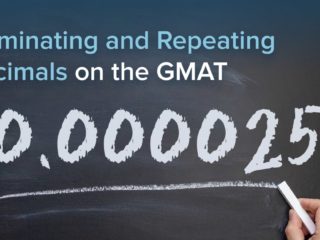Last Updated on May 9, 2023
GMAT OFFICIAL GUIDE DS –
Solution:
We are given that x, y, and z are three-digit positive integers. We are also given that x = y + z. We must determine whether the hundreds digit of x is equal to the sum of the hundreds digits of y and z.
Statement One Alone:
The tens digit of x is equal to the sum of the tens digits of y and z.
In order for statement one to be true, the sum of the tens digits of y and z must be less than 10. Let’s test some convenient numbers to illustrate this idea.
y = 143
z = 132
x = 275
Since 4 + 3 = 7, the tens digit of x is equal to the sum of the tens digits of y and z.
Since 1 +1 = 2, we also see that the hundreds digit of x is equal to the sum of the hundreds digits of y and z.
The concept here is:
Since x = y + z, the sum of the hundreds digits of y and z must be no more than 9 and there cannot be a “1” carrying over to the thousands place, because x is only 3 digits. In other words, the sum of the hundreds digits of y and z will be equal to the hundreds digit of x UNLESS there is a “1” carrying over from the sum of the tens digits of y and z to the hundreds place. However, we see that (from the example shown above) if the sum of the tens digits of y and z is equal to the tens digit of x, the sum of the tens digits of y and z will be no more than 9. And if the sum of the tens digits of y and z is no more than 9, there will not be a “1” carrying over to the hundreds place. Therefore, the sum of the hundreds digits of y and z will be indeed equal to the hundreds digit of x.
Thus, we see that statement one is sufficient to answer the question. We can eliminate answer choices B, C, and E.
Note: Notice that if we selected numbers in which the sum of the tens digit of y and z was 10 or higher, those numbers would not have fulfilled the information in statement one.
y = 143
z = 172
x = 315
Notice that 4 + 7 ≠ 1. In other words the tens digit of x IS NOT equal to the sum of the tens digits of y and z. Thus, we cannot use numbers in which the sum of the tens digits of y and z is 10 or higher.
Statement Two Alone:
The units digit of x is equal to the sum of the units digits of y and z.
From the work we did in statement one, we can see that knowing only that the units digit of x is equal to the sum of the units digits of y and z is not enough information to determine whether the hundreds digit of x is equal to the sum of the hundreds digits of y and z.
Case #1
y = 143
z = 172
x = 315
In this case 1 + 1 ≠ 3, so the hundreds digit of x IS NOT equal to sum of the hundreds digits of y and z.
Case #2
y = 143
z = 132
x = 275
In this case 1 + 1 = 2, so the hundreds digit of x is equal to sum of the hundreds digits of y and z.
Statement two alone is not sufficient to answer the question.
Answer: A



